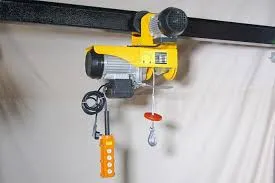


The Heavy Duty Chain Block An Essential Tool for Lifting and Moving Heavy Loads
In the world of construction, manufacturing, and heavy lifting, efficiency and safety are paramount. One of the most reliable tools that professionals turn to for these tasks is the heavy duty chain block. This device, often referred to as a chain hoist or block and tackle, has proven itself over decades as an indispensable element in various industries. With its robust design and mechanical advantage, a heavy duty chain block makes lifting and moving heavy items not only feasible but also safe.
What is a Heavy Duty Chain Block?
A heavy duty chain block consists of a chain that runs through a system of gears, allowing the user to lift and lower heavy loads with minimal physical effort. The common components include a hook for attachment, the lifting chain itself, a hand chain for operation, and a robust frame that houses the lifting mechanism. By pulling on the hand chain, the user engages the gears and lifts the load attached to the hook. This mechanical system reduces the required input force, demonstrating the basic principles of physics in a practical application.
Advantages of Using Heavy Duty Chain Blocks
1. Increased Lifting Capacity Heavy duty chain blocks are designed to handle significant weight, often supporting loads ranging from one ton to several tons. This capacity makes them ideal for heavy construction materials, machinery, and even vehicles.
2. Efficiency The lifting mechanism of a chain block allows individuals to lift heavier weights than they could by hand alone. This efficiency not only saves time but also reduces the physical strain on workers, making tasks less labor-intensive.
3. Versatility Chain blocks come in various sizes and capacities, allowing them to be used in numerous applications, from construction sites to warehouses. They can be employed for lifting heavy equipment, moving machinery, or for tasks in shipyards and factories.
4. Safety Safety features are paramount in the design of heavy duty chain blocks. Quality models usually come with built-in brakes to prevent accidental dropping of loads. When used correctly, they provide a safer alternative to less secure lifting methods.
5. Cost-Effectiveness Compared to other lifting mechanisms like electric hoists, manual chain blocks are typically more affordable, require less maintenance, and have a longer lifespan when properly cared for.

How to Use a Heavy Duty Chain Block Safely
While heavy duty chain blocks are robust and reliable, safe usage should always be a priority. Here are some guidelines
1. Inspect Before Use Always conduct a thorough inspection of the chain block before use. Look for signs of wear, including frayed chains or damaged hooks. A compromised chain block can lead to severe accidents.
2. Know the Load Limit Ensure that the weight being lifted does not exceed the chain block’s rated capacity. Overloading can lead to mechanical failure and serious injury.
3. Use on Stable Ground Ensure the chain block is set up on stable and level ground. An unstable base can cause the load to topple, leading to dangerous situations.
4. Secure the Load Always attach and secure the load properly to the hook to prevent slippage during lifting.
5. Train Operators Ensure that all operators are properly trained in the use of the chain block and understand the safety protocols necessary for its operation.
Conclusion
The heavy duty chain block is an essential tool that enhances productivity and safety in lifting and moving heavy loads across various industries. Its simple yet effective design allows for ease of use, making it accessible for both experienced professionals and novices alike. By understanding its advantages and adhering to safety protocols, users can maximize the benefits of this indispensable lifting equipment, ensuring that heavy lifting tasks are completed efficiently and safely. Whether on a construction site, in a warehouse, or in a manufacturing facility, the heavy duty chain block continues to be a trusted ally in the pursuit of effective material handling.



